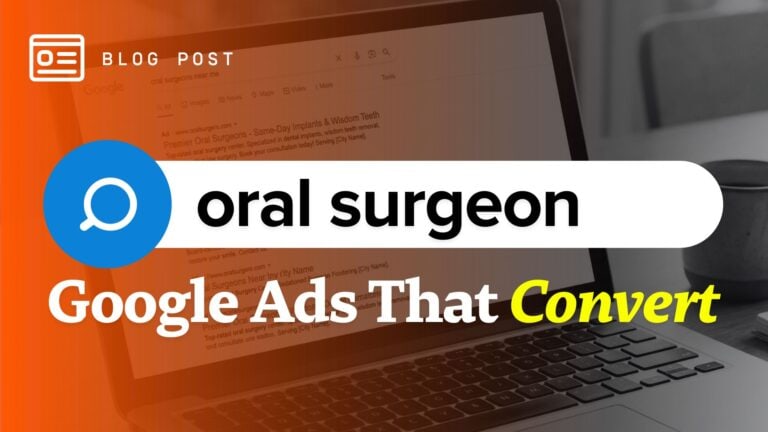When you do an online search for orthodontists, do you have to scroll to the second page of search results before you see your website?
They say if you’ve got something to hide, put it on the second page of Google because nobody ever looks there—in fact, 91% of searchers don’t go past the first page when looking online.
The first result also saw a click-through rate of over 10X that of the tenth result. So, if your website is towards the bottom of the page, and your competitor is towards the top, they could be getting 10X the number of inquiries that you do.
You’ve already invested in your website, but it could be doing more for your orthodontic practice. It could be a powerful tool for attracting potential patients, but if your site isn’t at the top of Google Search results, those patients are going to your competition.
So if you want to start using your orthodontic website as a tool to get more new patients, it’s time to start moving up in Google Search rankings.
But how?
The key is optimizing your orthodontic website with proven SEO strategies.
What Is SEO For Orthodontists?
SEO stands for Search Engine Optimization, and it’s a process of using various techniques to ensure your orthodontic practice appears higher on Google’s Search Engine Results Page (or SERP, for short.)
[insert image of a SERP listing for ‘best orthodontist tampa’ w/caption “This is a Search Engine Results Page, or SERP”]
There are billions of websites on the internet. The only way to find what you’re looking for— whether that’s an orthodontist, cheap flights, or the closest gas station— is with a search engine. And Google runs the biggest search engine by far, capturing a whopping 89% of mobile search traffic!
Google uses an automated software called a web crawler or spider that scours the internet to find information about your website and every other website on the internet. And then it uses a proprietary algorithm to decide which websites to show for any given search.
Google wants everybody to use its search engine, so they are constantly trying to make their search results more relevant to the user’s intent by adjusting the algorithm to make the SERPs even better and ensure people give their money to businesses they can trust.
That’s important for orthodontists and the healthcare industry as a whole because Google doesn’t want the user to be lured to the internet equivalent of a snake-oil salesman. Spending real money on bad care in the real world is a serious situation!
What Makes Your Orthodontic Website Rank Higher In Google Search Rankings?
That’s all in the algorithm. Google tends to be tight-lipped about the technical specifics of their algorithm, but they have talked publicly about some of the factors they consider important. SEO specialists have also found many approaches to website building and optimization proven to impact SERP rankings, such as:
- Page speed
- Mobile-first design
- Keywords in title and header tags
- Consistent publication of engaging content
- User engagement and experience
- Structured data and schema markup
- Niche expertise
So, if you know what these SEO ranking criteria are, you can apply them to your orthodontic practice’s website to turn it into the money-making tool it was always meant to be!
Boost Your Rankings With These Winning Tips For Orthodontic SEO…
SEO has the need for speed!
Google’s algorithm loves fast, responsive websites that work well on mobile and desktop. It’s all about delivering a good user experience. People don’t like web pages that are slow to load, and if it takes a few seconds too long, they’ll just leave and go to another website.
When a user leaves your website without spending any time on it, Google knows they encountered a bad user experience. Maybe it was slow, or maybe not relevant to the search. Either way, it impacts the bounce rate for your site. If your orthodontic website has a high bounce rate, it is less likely to rank highly on the search results page.
A website that takes five seconds to load sees over 4X the bounce rate of a website that takes two seconds to load, so you can improve your orthodontic practice’s SEO results on speed alone!
Serve Your Google Searches In A To-Go Cup.
A recent study showed that 65% of all searches come from mobile devices. Google has noticed this trend and has taken a “mobile-first” approach for the last several years. If your website isn’t designed around the mobile experience, you may be getting bumped down in the SERP rankings.
Websites that aren’t fast, attractive, and functional on mobile can only be found on the dreaded Page 2. At least they’re probably there, but nobody knows…because nobody looks at Page 2!
Google penalizes websites that provide a poor mobile experience, so your orthodontic practice needs to take mobile optimization seriously to win at SEO. That means the design of your website must be responsive, so it can load quickly and look great on a wide variety of screen sizes and resolutions automatically.
Your website design should also account for the different ways a user engages with mobile websites. The screen is smaller, so the text needs to be bigger. There is much more scrolling on a handheld touchscreen, so your website has to be designed with that in mind.
Do your Homework On Orthodontic SEO Search Terms.
Google’s algorithm relies on keywords to pair a search with relevant websites. A keyword is a word or phrase that describes what the user is searching for. Ideally, you optimize your orthodontic website by placing SEO keywords throughout your site, so Google knows your site is relevant to the search.
For example, if someone searches “how does Invisalign work,” your website may not appear. Even though you are an orthodontist that provides Invisalign as a key part of your business, if you don’t have that phrase anywhere on your website, Google might not rank your website very high on the SERP.
The easiest way to find the best SEO keywords for orthodontists is by using Google’s autocomplete suggestions in the search bar. You could start with “how Invisalign” and see that Google autocompletes “how does Invisalign look on teeth” and “how does Invisalign work” and more.
If you have a blog article on your website with one of those topics as a title, Google will find your information relevant to the search and recommend your site to the user. That’s a potential patient, and the more time they spend on your website finding more information, the higher your site will rank on the results page.
You can create engaging content on all kinds of topics relevant to orthodontics. The more, the better; you can always add more as you find new trending keywords. Regularly updating your website with quality content goes a long way to reaching the top of Google Search!
Put Your SEO Keywords In Header Tags.
Let’s say you wanted a page with “What Orthodontists Do” as the title. You would want the type bigger than the rest of the text. You could just change the font size or color to make the text look big or bold or a different color. But while the user would see the bold text and highlighted color, a web crawler would only see more text.
Instead, you need to use heading tags to add hierarchy to titles, subtitles, headings, and subheadings in a way that a web crawler will recognize. An H1 designation would appear larger than an H2, or H3 and so on. But header tags also tell a web crawler that the H1 is more important than the H2, and that your H2 is much more important than basic body text. So the keywords used in headers will be understood as the most important content on your page.
Using the example above, by giving your “What Orthodontists Do” keyword an H1 tag, you’d ensure that it is the largest text on the page and Google knows it is important information. Google definitely favors websites that use header tags, so be sure they’re optimized on your site.
E.A.T. Your Way To The Top Of Search Results.
E.A.T. is another Google acronym that stands for Expertise, Authority, and Trustworthiness. E.A.T. is even more important for SEO on orthodontist websites because there can be a real-world impact to the users’ health. As a result, Google needs to ensure you have plenty of expertise, authority, and trustworthiness before they tell users to visit your site.
You can add some E.A.T. to your website by making sure you have a detailed About page with a name, address, and phone that is consistent across the web. You’ll also want to prominently display your certifications, awards, and memberships to orthodontic organizations on your site.
A Contact page lets Google know you are a real business that is easy to contact if need be. You should also have your reviews available on your page and respond to all your reviews across the internet.
Finally, one of Google’s ranking factors is the “consistent publication of engaging content.” You don’t build authority by simply publishing your website and calling it a day. The more active your orthodontic practice is online—publishing helpful blog articles, making social media posts, and adding content to your Google Business Profile—the stronger your authority will be and the higher you’ll climb in the search rankings.
These points will signify to web crawlers that you know your stuff, you are known in your field, and people can trust you.
Structure Your Website Data Like An SEO Pro!
Markup is the set of symbols that provide instructions to web browser software to display content. You may have heard of HTML. It stands for HyperText Markup Language. So when a web designer makes a website, they are “marking up” content so it displays correctly on your computer or smartphone.
But there are different ways to do this, some of which aren’t web crawler friendly.
Structured data markup is, however. It can be used to display images, tables, quotations, and lists in a way that tells a web crawler what the information is. Google likes structure, which will help your website rank higher on SERPs.
Schema.org has a list of markups that all the major search engines have agreed upon. Schema is the markup style standard. There are online tools to evaluate your website and recommend ways to add structured data, like the Yoast plugin from WordPress.
You do want to make sure you’re doing it right, as data errors can keep your website from reaching the top of SEO results for orthodontic practices in your area.. If you’re not sure if you’re doing it right, consider hiring a professional.
Master SEO For Orthodontists To Blast Your Way To The Top Of Google Search!
Are you ready to see your practice dominate Google Search results? You’ve worked too hard to watch your practice get buried online. It’s time to see all your work and experience reflected with a website that doesn’t get lost in the shuffle!
These tips may get you started, but if you don’t have the time or skills to implement them, an SEO professional can help your website shoot up the rankings quickly.
Using SEO to boost your online presence is just one part of the puzzle to unlock explosive growth in your orthodontics practice. HIP has helped hundreds of orthodontists like you go from the bottom of the barrel to the top of the charts with their Patient Acquisition and Retention Framework [PARF™]. Schedule a discovery call with HIP today!




